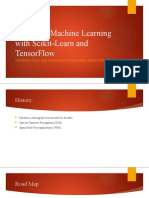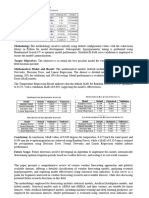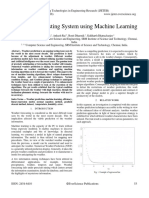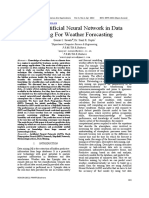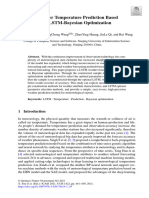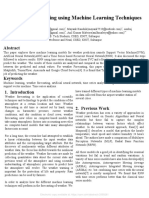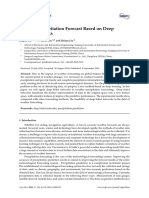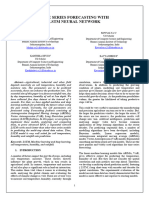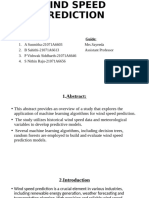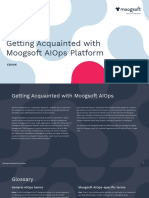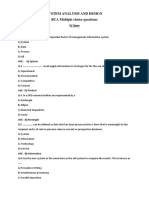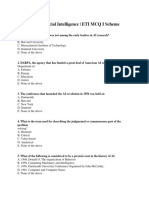3
3
Uploaded by
RahulCopyright:
Available Formats
3
3
Uploaded by
RahulOriginal Description:
Copyright
Available Formats
Share this document
Did you find this document useful?
Is this content inappropriate?
Copyright:
Available Formats
3
3
Uploaded by
RahulCopyright:
Available Formats
2.
Prediction of Weather Forecast for Smart Agriculture supported by Machine Learning (364)
This paper entitled "Forecasting Weather Conditions for Smart Agriculture Using Machine Learning"
introduces machine learning regression methods to predict weather conditions for the development of smart
irrigation systems. It investigates various machine learning regression algorithms such as Random Forest
(RF), Neural Networks (NN), Decision Trees (DT), and Linear Regression (LR) to forecast weather
parameters for upcoming hours. Through cross-validation, it demonstrates that Random Forests and
Decision Trees exhibit the highest efficiency. The model takes input parameters such as field location
(latitude and longitude), date (day, month, and year), and outputs predicted weather forecasts including
temperature, wind speed, precipitation, and evapotranspiration. This prediction capability aims to reduce
water wastage and promote sustainable agricultural practices.
Dataset:The dataset utilized is sourced from the "JRC MARS Meteorological Database," containing
meteorological observations interpolated on a 25x25 km grid, on a daily basis from 1979 to the most recent
complete calendar year, covering the European Union and neighboring countries, obtained from the
Agri4Cast database.
Methodology:The methodology involves initially using default configuration values with the scikit-learn
library in Python for model development. Subsequently, hyperparameter tuning is performed using
Randomized Search CV to optimize model performance. Stratified K-Fold cross-validation is employed to
ensure the model's generalization.
Target/ Objectives: The objective is to obtain the best possible model for weather forecasting based on
field location and date.
Mathematical Model and Result: The mathematical models utilized include Random Forest, Neural
Networks, Decision Trees, and Linear Regression. The dataset is divided into three groups: 70% for
training, 20% for validation, and 10% for testing. Model performance is evaluated using the Mean Absolute
Error (MAE) metric.
The Temperature Regression Result indicates that the default MAE for Random Forest is 0.476, optimized
to 0.473, with a validation MAE of 0.639, suggesting the model's effectiveness.
Conclusion: In conclusion, MAE values of 0.639 degrees for temperature, 0.472 km/h for wind speed, and
0.194 mm for evapotranspiration are achieved using Random Forest, while a MAE of 0.324 mm is attained
for precipitation using Decision Trees. Neural Networks and Linear Regression exhibit inferior
performance.
Future Scope: Future directions involve developing an algorithm to implement this model, automatically
determining optimal irrigation periods based on weather forecasts, and testing it in real-world scenarios.
3. Deterministic weather forecasting models based on intelligent predictors: A survey
The evolution of weather forecasting into the era of Big Data is propelled by advancements in climate
observation systems like satellite meteorological observation and the exponential growth in weather data
volume. Traditional computational intelligence models struggle to accurately predict weather patterns in
this data-rich environment. Consequently, there's a shift towards employing deep learning techniques to
effectively process vast datasets and enhance prediction accuracy by learning from historical data.
Technologies such as the Internet of Things, Wireless Sensor Networks, and Cloud Computing further
facilitate this transition, leading to more precise predictions of future climate states. Additionally,
advancements in deep learning techniques and data visualization methods contribute to more effective and
accurate weather forecasting and climate prediction. Therefore, utilizing deep learning approaches to
extract valuable insights from weather data is justifiable, as these techniques leverage layered neural
networks to accurately identify and extract meaningful patterns from large datasets.
This paper presents a comprehensive review of various weather forecasting approaches and publicly
available datasets, offering a detailed classification of weather forecasting models, analyzing essential
hyperparameters, and exploring model effectiveness using statistical error indicators. It also serves as a
guide for beginners interested in weather forecasting research and available datasets, while also discussing
potential future research directions in this field.
The methodology employed for forecasting includes statistical models, Artificial Intelligence models, and
hybrid models. Statistical models such as ARMA and ARIMA, and their variants, are suitable for linear
datasets, while Artificial Intelligence models, including machine learning and deep learning predictors, are
employed for non-linear datasets. Model performance is evaluated using statistical error indicators like
MAE, RMSE, MAPE, and R2, with results visualized using scatter plots, line plots, and semilog plots to
accurately compare actual and predicted values.
Challenges and future directions in weather forecasting research include the need for improved data
collection, addressing the use of small datasets in experiments, focusing on other weather parameters like
rainfall and dew point prediction, exploring forecasting models using atmospheric images, developing more
multivariate models, and evaluating model stability in addition to prediction accuracy.
In conclusion, with the advancement of Big Data technologies and deep learning techniques, weather
forecasting and climate prediction can be conducted effectively and accurately. The paper provides insights
into recent research in weather forecasting, along with a detailed analysis of results, classification of
forecasting models, available datasets, challenges, and future research directions. Additionally, it highlights
the need for assessing model stability alongside prediction accuracy and identifies promising techniques
such as artificial neural networks (ANN) and support vector machines (SVM) for weather forecasting.
You might also like
- Weather Prediction Using Machine Learning TechniquessDocument53 pagesWeather Prediction Using Machine Learning Techniquessbakiz89No ratings yet
- Hands-On Machine Learning With Scikit-Learn and TensorFlowDocument18 pagesHands-On Machine Learning With Scikit-Learn and TensorFlowHiba Khurshid100% (1)
- 2Document2 pages2RahulNo ratings yet
- 4Document2 pages4RahulNo ratings yet
- Weather Prediction With Machine LearningDocument5 pagesWeather Prediction With Machine LearningInternational Journal of Innovative Science and Research TechnologyNo ratings yet
- R1-Weather Prediction Mode1Document7 pagesR1-Weather Prediction Mode1Manimegalai C TNo ratings yet
- (IJCST-V11I2P6) :dr. Imtiyaz Khan, Muhammad Umar Khan, Muaaz Mulla, Dr.M.Upendra KumarDocument5 pages(IJCST-V11I2P6) :dr. Imtiyaz Khan, Muhammad Umar Khan, Muaaz Mulla, Dr.M.Upendra KumarEighthSenseGroupNo ratings yet
- Literature 04Document5 pagesLiterature 04sameerkhaan96891No ratings yet
- Machine Learning Methods To Weather Forecasting To Predict Apparent TemperatureDocument11 pagesMachine Learning Methods To Weather Forecasting To Predict Apparent TemperatureIJRASETPublications100% (1)
- Research Paper Rain Prediction SystemDocument6 pagesResearch Paper Rain Prediction Systemz8538350No ratings yet
- Untitled DocumentDocument7 pagesUntitled Documentvaishnavi khangarNo ratings yet
- 1st Paper On Weather PredictionDocument4 pages1st Paper On Weather PredictionE SAI KRISHNANo ratings yet
- 29 July2023Document10 pages29 July202321bq1a0555No ratings yet
- 244 PDFDocument5 pages244 PDFRaul Guillen CruzNo ratings yet
- Weather Forecasting Using Neural Network IJERTCONV5IS01197Document4 pagesWeather Forecasting Using Neural Network IJERTCONV5IS01197gunjiramya92No ratings yet
- 365-Article Text-2346-1-10-20230515Document8 pages365-Article Text-2346-1-10-20230515MIZANUR RAHMANNo ratings yet
- Weather Forecasting and Prediction Using Hybrid C5.0Document14 pagesWeather Forecasting and Prediction Using Hybrid C5.0Logan Paul100% (1)
- Term Paper of Digital Signal ProcessingDocument6 pagesTerm Paper of Digital Signal Processingjitenderthakur490No ratings yet
- Final ReportDocument30 pagesFinal ReportThương VănNo ratings yet
- DaoGiaKhanh Weather Forecasting Using MachineLearningDocument8 pagesDaoGiaKhanh Weather Forecasting Using MachineLearningphleminhchauneuNo ratings yet
- Web Traffic Time Series Forecasting of Temperature AnalysisDocument4 pagesWeb Traffic Time Series Forecasting of Temperature AnalysisInternational Journal of Innovative Science and Research TechnologyNo ratings yet
- Solar Energy Prediction Using Decision Tree RegressorDocument14 pagesSolar Energy Prediction Using Decision Tree Regressorf20201729No ratings yet
- IJEDR1702035Document4 pagesIJEDR1702035DejenieNo ratings yet
- FOURDocument9 pagesFOUROrah SeunNo ratings yet
- Rainfall Prediction System 2Document6 pagesRainfall Prediction System 2Salim AnsariNo ratings yet
- Problem DefinitionDocument4 pagesProblem Definitionusha100% (1)
- ESDRERRSelectionsDocument18 pagesESDRERRSelectionsKoert OosterhuisNo ratings yet
- Prediction Rainfall With Regression AnalysisDocument12 pagesPrediction Rainfall With Regression AnalysisIJRASETPublications100% (1)
- Temperature and Humidity Data Analysis For Future Value Prediction Using Clustering Technique: An ApproachDocument4 pagesTemperature and Humidity Data Analysis For Future Value Prediction Using Clustering Technique: An Approachpitchrks19841No ratings yet
- 1 s2.0 S0038092X11000193 MainDocument11 pages1 s2.0 S0038092X11000193 MainJim AkisNo ratings yet
- Anjali 2019Document5 pagesAnjali 2019raju031001No ratings yet
- CSE-873d MergedDocument9 pagesCSE-873d Mergedshivabasav s kNo ratings yet
- Advances in Artificial Intelligence and Security 2021 471 480Document10 pagesAdvances in Artificial Intelligence and Security 2021 471 480gita.bangtan24No ratings yet
- Precipitation ForecastDocument17 pagesPrecipitation Forecastmerve jaliliNo ratings yet
- AI Project Buissness Document FilesDocument21 pagesAI Project Buissness Document Filesanaya020903No ratings yet
- Hybrid Algorithm of Backpropagation and Relevance Vector Machine With Radial Basis Function Kernel For Hydro-Climatological Data PredictionDocument11 pagesHybrid Algorithm of Backpropagation and Relevance Vector Machine With Radial Basis Function Kernel For Hydro-Climatological Data PredictionPustaka SemestaNo ratings yet
- Final ReportDocument9 pagesFinal ReportsugoallacacciatoraNo ratings yet
- s3950476 TimeSeriesAnalysis Assignment 3Document13 pagess3950476 TimeSeriesAnalysis Assignment 3Namratha DesaiNo ratings yet
- 10 1109@icesc48915 2020 9155571Document4 pages10 1109@icesc48915 2020 9155571Sushmitha ThulasimaniNo ratings yet
- KNN Technique For Analysis and Prediction of Temperature and Humidity DataDocument7 pagesKNN Technique For Analysis and Prediction of Temperature and Humidity DataJaineet ShahNo ratings yet
- SSRN Id3350281Document6 pagesSSRN Id3350281Shivangi MishraNo ratings yet
- Algorithms 11 00132 PDFDocument11 pagesAlgorithms 11 00132 PDFnos88No ratings yet
- Atmosphere 14 01635Document27 pagesAtmosphere 14 01635Diego VidalNo ratings yet
- (IJCST-V10I2P14) :prof. A. D. Wankhade, Bhagyashri Jaiswal, Divya Gupta, Mahima Gadodiya, Sanket RautDocument4 pages(IJCST-V10I2P14) :prof. A. D. Wankhade, Bhagyashri Jaiswal, Divya Gupta, Mahima Gadodiya, Sanket RautEighthSenseGroupNo ratings yet
- Internship PDFDocument12 pagesInternship PDFHarikrishnan NairNo ratings yet
- Ws 022033448Document14 pagesWs 022033448ChalaTameneNo ratings yet
- Predicting Climate Variability Over The PDFDocument8 pagesPredicting Climate Variability Over The PDFAnkur VishalNo ratings yet
- Time Series Data Analysis For Forecasting - A Literature ReviewDocument5 pagesTime Series Data Analysis For Forecasting - A Literature ReviewIJMERNo ratings yet
- Big Data Analytics in Forecasting Lakes LevelsDocument4 pagesBig Data Analytics in Forecasting Lakes LevelsInternational Journal of Application or Innovation in Engineering & ManagementNo ratings yet
- LSTM PaperDocument5 pagesLSTM Paperkowsalya.cs21No ratings yet
- A Machine Learning Approach For Rainfall Estimation IntegratingDocument11 pagesA Machine Learning Approach For Rainfall Estimation Integrating217r1a0597No ratings yet
- Environmental Temperature Prediction Using A Data Analysis and Neural Networks Methodological ApproachDocument6 pagesEnvironmental Temperature Prediction Using A Data Analysis and Neural Networks Methodological ApproachEvaluaciones UTNNo ratings yet
- 3 Al 5 de Octubre de 2012 - Buenos Aires, ArgentinaDocument6 pages3 Al 5 de Octubre de 2012 - Buenos Aires, Argentinacristian6378No ratings yet
- Temperature Forecasting For Dar Es Salaam City Using Artificial Neural Network PDFDocument7 pagesTemperature Forecasting For Dar Es Salaam City Using Artificial Neural Network PDFInternational Journal of Innovative Science and Research TechnologyNo ratings yet
- DTIDocument8 pagesDTIAyushNo ratings yet
- Meteorological Applications - 2021 - Hu - Deep Learning Based Precipitation Bias Correction Approach For Yin He GlobalDocument14 pagesMeteorological Applications - 2021 - Hu - Deep Learning Based Precipitation Bias Correction Approach For Yin He Globalcompracliente081No ratings yet
- WIND SPEED PREDICTION (Abstract Review)Document11 pagesWIND SPEED PREDICTION (Abstract Review)harimedia0306No ratings yet
- An Ann Based Weather Forecasting SystemDocument4 pagesAn Ann Based Weather Forecasting Systemdhyandutta100% (1)
- Assignment#3: DR - Azhar UL HaqDocument9 pagesAssignment#3: DR - Azhar UL HaqmuzammalNo ratings yet
- Sugarcane Yield Grade Prediction Using Random Forest With Forward Feature Selection and Hyper-Parameter TuningDocument11 pagesSugarcane Yield Grade Prediction Using Random Forest With Forward Feature Selection and Hyper-Parameter Tuninganushkachauhan9099No ratings yet
- 05 Ai Ethics Ix Class-1Document16 pages05 Ai Ethics Ix Class-1Vikas Verma100% (1)
- Just-In-Time and Lean ManufacturingDocument55 pagesJust-In-Time and Lean ManufacturingVandana LonkarNo ratings yet
- P.E.S. College of Engineering, MANDYA, 571401: Identifying The Android Malware Using Machine Learning AlgorithmDocument34 pagesP.E.S. College of Engineering, MANDYA, 571401: Identifying The Android Malware Using Machine Learning AlgorithmAdarsha SNo ratings yet
- Elements of AutomationDocument17 pagesElements of Automationcssp115No ratings yet
- IEEE Paper Format TemplateDocument4 pagesIEEE Paper Format TemplateHarsh GuptaNo ratings yet
- What Is Product Analysis - Project Management KnowledgeDocument8 pagesWhat Is Product Analysis - Project Management KnowledgeasdgasdfasdfassdfasdfNo ratings yet
- DafpusDocument3 pagesDafpuswerryNo ratings yet
- Hot Topics in Machine Learning For Research and ThesisDocument10 pagesHot Topics in Machine Learning For Research and ThesisWrite MythesisNo ratings yet
- Turner, Ryan - Python Machine Learning - The Ultimate Beginner's Guide To Learn Python Machine Learning Step by Step Using Scikit-Learn and Tensorflow (2019)Document144 pagesTurner, Ryan - Python Machine Learning - The Ultimate Beginner's Guide To Learn Python Machine Learning Step by Step Using Scikit-Learn and Tensorflow (2019)Daniel GNo ratings yet
- Neural Networks: Learning: Cost FunctionDocument33 pagesNeural Networks: Learning: Cost FunctionLydia DarlaNo ratings yet
- Functional Safety SILDocument22 pagesFunctional Safety SILDirk Van MechelenNo ratings yet
- Approaches and Methods in Computational LinguisticsDocument18 pagesApproaches and Methods in Computational LinguisticsMaryam AfzalNo ratings yet
- Anas Khan2345667898ijhgfdewsazxcvghuytresDocument2 pagesAnas Khan2345667898ijhgfdewsazxcvghuytresFOR KIND ONESNo ratings yet
- Artificial Intelligence QuestionsDocument15 pagesArtificial Intelligence QuestionsvigneshNo ratings yet
- Transshipment Model in The Function of Cost Minimization in A Logistics SystemDocument12 pagesTransshipment Model in The Function of Cost Minimization in A Logistics SystemsyazanaNo ratings yet
- Moogsoft Ebook Getting Acquainted With Aiops PlatformDocument32 pagesMoogsoft Ebook Getting Acquainted With Aiops PlatformChandan KumarNo ratings yet
- Availability Check and Atp CheckDocument4 pagesAvailability Check and Atp CheckyareddyNo ratings yet
- Iso 9001 - 2008Document12 pagesIso 9001 - 2008jsstyNo ratings yet
- Autocom Application Trucks CDPDocument624 pagesAutocom Application Trucks CDPEloyAlonsoMiguelNo ratings yet
- Agile Processes and Methodologies: A Conceptual Study: Sheetal SharmaDocument1 pageAgile Processes and Methodologies: A Conceptual Study: Sheetal Sharmarahul priyankaNo ratings yet
- AI (6th) May2022Document2 pagesAI (6th) May2022Armaan SinghNo ratings yet
- Flowshop Final ReportDocument40 pagesFlowshop Final Reportfatmazohra rezkellahNo ratings yet
- Functional Memento ImplemDocument23 pagesFunctional Memento ImplemDiana GonzálezNo ratings yet
- Introduction To Kanban BoardsDocument3 pagesIntroduction To Kanban BoardskeerthanaNo ratings yet
- Systen Analysis and DesignDocument38 pagesSysten Analysis and DesignParmpreet Singh100% (2)
- Lesson 2 - EcologyDocument59 pagesLesson 2 - EcologyApril Christine Mae ApuraNo ratings yet
- (DEAP描述) Accurate EEG-Based Emotion Recognition on Combined Features Using Deep Convolutional Neural NetworksDocument12 pages(DEAP描述) Accurate EEG-Based Emotion Recognition on Combined Features Using Deep Convolutional Neural NetworksWei LiNo ratings yet
- Shortlist 2Document1 pageShortlist 2rahul dandonaNo ratings yet
- Chapter 1 MCQ Word File Class TestDocument13 pagesChapter 1 MCQ Word File Class TestbansalhemantNo ratings yet

